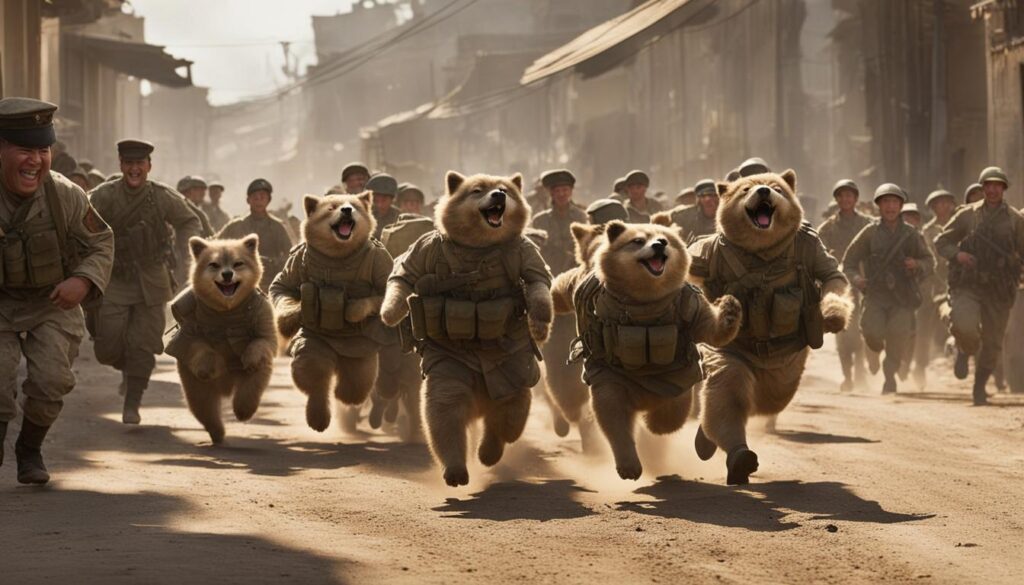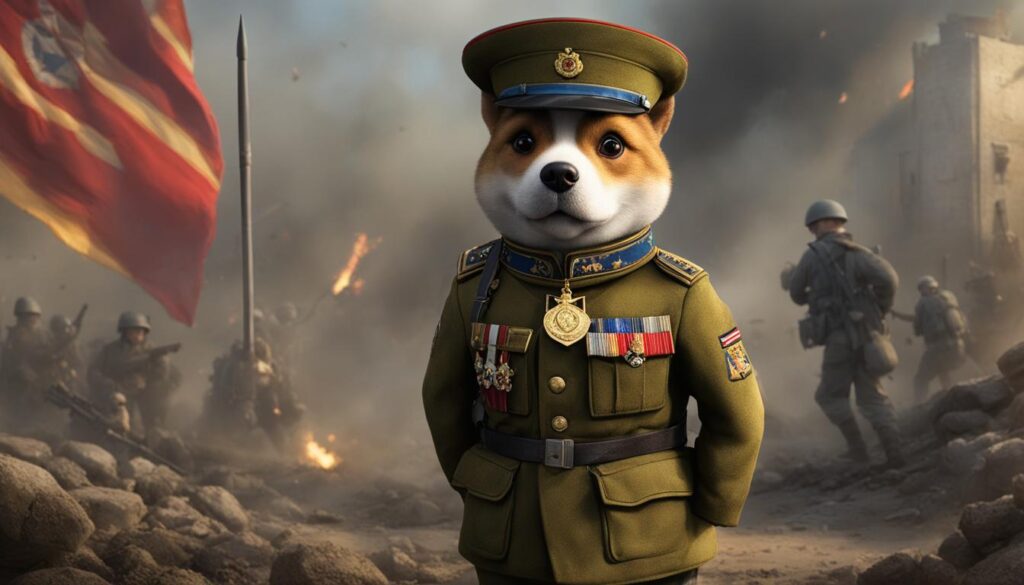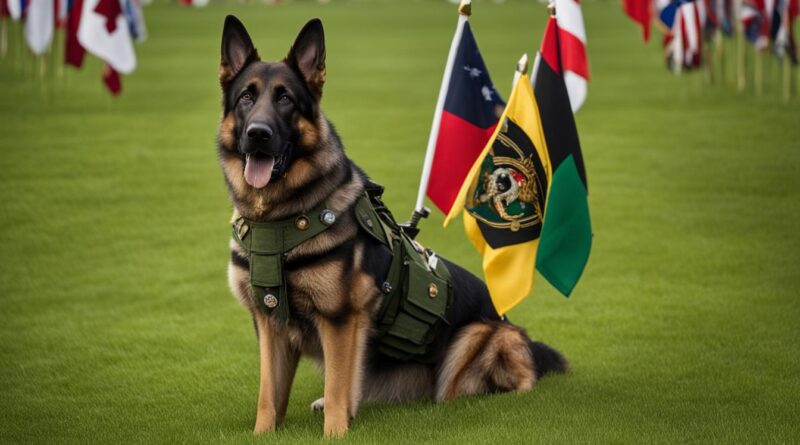Highest Military Rank Achieved by a Dog Revealed
When it comes to military service, dogs have played a crucial role throughout history. They have provided companionship to soldiers, acted as mascots, and even performed vital tasks on the battlefield. But have you ever wondered what the highest military rank achieved by a dog is? In this article, we will explore the fascinating story of one famous military dog and discover the answer to this intriguing question.
Meet Stubby, a remarkable dog who served as the mascot of the 102nd Infantry, 26th Yankee Division during World War I. Stubby’s dedication and bravery led to him attaining the highest military rank ever achieved by a dog – Sergeant.
Stubby’s journey began when he befriended Private J. Robert Conroy during training at Yale University. Impressed by Stubby’s loyalty and intelligence, Conroy took him under his wing and brought him along to the front lines as the official mascot of the 102nd Infantry.
Stubby’s service in the war was nothing short of extraordinary. He learned military drills and bugle calls, and even had a modified dog salute. But it was his actions on the battlefield that truly set him apart. Stubby saved countless lives by warning soldiers of gas attacks, locating wounded men in the trenches, and capturing a German soldier.
His heroism did not go unnoticed. Stubby received multiple awards and medals for his service, making him the most decorated dog in American history. His story captivated the nation, and he became a symbol of loyalty and bravery.
Key Takeaways:
- The highest military rank achieved by a dog is Sergeant.
- Stubby, a dog who served in World War I, attained this rank as the mascot of the 102nd Infantry, 26th Yankee Division.
- Stubby’s heroism and bravery included saving soldiers from gas attacks and locating wounded men on the battlefield.
- He received multiple awards and became a celebrity after the war.
- Stubby’s story highlights the important role of military working dogs in the armed forces.
Stubby: The Heroic Military Dog of World War I
Stubby, a brindle puppy with a short tail, befriended Private J. Robert Conroy during training for combat at Yale University in 1917. He became the mascot of the 102nd Infantry, 26th Yankee Division and was allowed to accompany the division to the front lines as their official mascot. Stubby displayed incredible bravery and heroism during his service, including warning soldiers of gas attacks and locating wounded men in the trenches.
Despite being injured multiple times, Stubby continued to serve until the end of the war, becoming a symbol of resilience and dedication. His military dog achievements did not go unnoticed as he received numerous medals for his service, including the Purple Heart and a Gold Medal from the Humane Education Society. Stubby’s heroic actions famous military dog accomplishments made him a beloved figure among soldiers and civilians alike.
After the war, Stubby became a celebrity and captured the hearts of people across the nation. He visited the White House, where he met with President Woodrow Wilson, and became the mascot of Georgetown University. Stubby’s story exemplifies the important role that dogs in the military play and their significant contributions to the armed forces.
“Stubby displayed incredible bravery and heroism during his service, including warning soldiers of gas attacks and locating wounded men in the trenches.”
Military Working Dogs in History
Dogs have a long history of service in the military, fulfilling various roles that contribute to the success of military operations. From ancient times to modern warfare, dogs have played a vital part in ensuring the safety and well-being of soldiers.
During World War I, dogs proved their worth and displayed exceptional capabilities on the battlefield. Different countries recognized the value of utilizing dogs in various roles and developed specialized programs and units to harness their unique abilities.
The Military Working Dog Hierarchy
In the military working dog hierarchy, there are different ranks and classifications that reflect a dog’s training level and responsibilities. These ranks provide structure and facilitate effective coordination between dogs and their human handlers.
At the top of the military working dog hierarchy are the top military dog ranks:
| Rank | Description |
|---|---|
| Master Military Working Dog | The highest-ranking dog in the military, demonstrating exceptional skills, expertise, and leadership. |
| Sergeant | A highly trained dog responsible for critical tasks and capable of working independently. |
| Corporal | A dog that has completed advanced training and can perform a wide range of specialized tasks. |
These ranks represent the pinnacle of achievement for military working dogs, showcasing their training accomplishments and capabilities.
The Role of Dogs in Different Countries
Various countries recognized the invaluable contributions dogs could make to their military operations during World War I. Let’s take a closer look at the roles of dogs in three prominent nations:
- Germany: Germany had the most well-trained canine force, with over 30,000 dogs serving in roles such as sentries, scouts, and casualty dogs. These dogs were trained extensively in obedience and combat skills, making them a formidable asset on the battlefield.
- France: France had the largest and most diverse dog units. They used different breeds for specific tasks, such as messenger dogs, sentry dogs, and aid dogs. These specialized units ensured that each dog had the necessary skills and traits suited to their designated role.
- United States: While the United States did not have a formal military dog program during World War I, dogs like Stubby played a crucial role as mascots and sources of support and companionship for soldiers. Stubby’s actions and the recognition he received highlighted the potential of dogs in the military.
The contributions of these dogs in World War I paved the way for the establishment of formal military working dog programs in many countries, recognizing the important role these animals play in supporting soldiers.
Stubby’s Journey to Military Service
Stubby’s journey to military service began when he wandered onto the grounds of Yale University, where the 102nd Infantry Regiment was training. Private J. Robert Conroy took a liking to the stray dog and formed a close bond with him. Stubby accompanied the regiment to France after being smuggled aboard the SS Minnesota. He became the unofficial mascot of the 102nd Infantry and quickly became beloved by the soldiers.
Stubby received training from the soldiers, learning drills and bugle calls, and even a modified dog salute. His presence boosted morale and he became a symbol of loyalty and bravery.

Stubby’s journey from a stray dog to a celebrated military dog exemplifies the incredible impact that canines have had in military settings. His story is just one example of the role that famous military dogs have played throughout history.
Stubby’s Heroic Actions and Recognition
During World War I, Stubby, the famous military dog, displayed incredible bravery and heroism on the battlefield. His sharp senses and ability to recognize danger saved the lives of many soldiers. Stubby’s heroic actions included:
- Saving soldiers from gas attacks
- Locating wounded men in no man’s land
- Capturing a German soldier
Stubby’s extraordinary courage and dedication earned him multiple awards and recognition. He became the most decorated dog in American history, receiving honors such as the Iron Cross medal that was originally awarded to the German spy he captured. Stubby’s remarkable achievements and service to the military showcased the invaluable contributions of military working dogs.
“Stubby’s actions on the battlefield demonstrated the unwavering loyalty and bravery of military working dogs. He became a symbol of inspiration and a testament to the close bond between humans and canines in times of war.” – General John J. Pershing
After the war, Stubby’s heroic story became well-known, capturing the public’s imagination. He met with presidents and dignitaries and was celebrated as a national hero. Stubby’s legacy continues to shine a light on the important role of military working dogs and their impact on the armed forces.
| Awards and Recognitions | Presentation |
|---|---|
| Purple Heart | For being injured in action |
| Yankee Division Medal | Presented by the 26th Yankee Division |
| Iron Cross | Originally awarded to a German spy captured by Stubby |

Stubby’s heroic deeds and the accolades he received showcased the extraordinary abilities of military working dogs and their unwavering dedication to their human counterparts. Throughout history, famous military dogs like Stubby have left an indelible mark on the armed forces, proving that courage knows no bounds, even in the form of a loyal four-legged companion.
Conclusion
The highest military rank attained by a dog is the Sergeant, a title earned through the remarkable actions of a World War I hero named Stubby. Stubby’s story serves as a testament to the courage and unwavering dedication of military working dogs that have faithfully served alongside soldiers throughout history.
These extraordinary canines have played vital roles in a wide range of tasks within the military, including guarding duties and the critical mission of locating wounded soldiers. Their contributions have not gone unnoticed, as they have been honored with numerous awards and medals, solidifying their status as symbols of loyalty and heroism.
Dogs like Stubby exemplify the indelible bond between humans and animals in military operations. Their legacy continues to inspire, reminding us of the significant role that these faithful companions play in protecting and serving our armed forces. As we reflect on their service, let us never forget the invaluable contributions of military working dogs in defending our nation.
FAQ
What is the highest military rank achieved by a dog?
The highest military rank achieved by a dog is Sergeant.
Who was the famous military dog in World War I?
The famous military dog in World War I was Stubby.
What were Stubby’s achievements in the military?
Stubby displayed bravery and heroism, saving soldiers from gas attacks and locating wounded men on the battlefield. He received multiple medals for his service and became a celebrity after the war.
What is the hierarchy of military working dogs?
There is no formal hierarchy for military working dogs, but their roles can vary depending on training and assignment.
How did Stubby become a military dog?
Stubby wandered onto the grounds of Yale University where the 102nd Infantry Regiment was training, and Private J. Robert Conroy formed a bond with him. He became the mascot of the regiment and accompanied them to France.
What were Stubby’s heroic actions in World War I?
Stubby saved soldiers from gas attacks, located wounded men in no man’s land, and even captured a German soldier. He became the most decorated dog in American history.
What is the significance of military working dogs?
Military working dogs have played essential roles in various tasks, from guard duty to locating wounded soldiers. They have been recognized for their contributions with awards and medals and serve as symbols of loyalty and heroism.
Are there other famous military dogs?
Yes, there have been other famous military dogs throughout history, each with their own courageous stories of service and loyalty.


